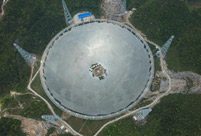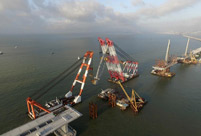

BEIJING, July 5 -- China's National Bureau of Statistics (NBS) has adopted a new method of calculating GDP that it says "better reflects the contribution of innovation to economic growth."
Research and development (R&D) expenditures that can economically benefit companies will no longer be calculated as intermediate consumption, but as fixed capital formation, the NBS said in a statement.
The adjustment was made according to the 2008 SNA (System of National Accounts), which was unveiled by five international organizations, including the United Nations, in 2009 to provide a"comprehensive, consistent and flexible set of macroeconomic accounts."
The NBS will use the method for future GDP calculations, and has also recalculated all figures dating back to 1952.
GDP for the previous six decades all rose due to the reform. In the past decade, the average annual increase in GDP volume due to the adjustment was 1.06 percent.
Recorded GDP growth rates in the past 10 years rose by an annual average of 0.06 percentage point. The growth rate for 2015 remained at 6.9 percent, revised upward by 0.04 percentage point.
The revision also brings slight changes to the economic structure, with the share of the industrial sector in 2015 rising from 40.5 to 40.9 while shares of agricultural and service sectors both go down.
The reform can "better reflect the contribution of innovation to economic growth," the statement said.
In recent years, China has promoted science, technology and creative development, with rapid growth in R&D expenditures and an increasingly important role for R&D to economic growth.
In May 2016, China unveiled a national strategy for innovation-driven development which identified a large number of tasks and projects and pledged greater investment.
Chinese President Xi Jinping told a national conference in May that the country should give more importance to scientific and technological innovation.
However, the old calculation method failed to reflect the importance of R&D, as intermediate consumption only measures value of goods and services that are transformed or entirely used up in the course of production.
In reality, R&D expenditures that yield economic benefit should not be considered "completely used up in the accounting period," and thus should be recorded as fixed capital formation, according to the 2008 SNA.
The NBS move can reflect the effects of China's push for mass entrepreneurship and innovation, highlight the role of science and technology in growth, and in turn stimulate new investment in R&D, the statement said.
At present, most member countries of the Organization for Economic Cooperation and Development (OECD) and some developing countries use the 2008 SNA framework to calculate R&D expenditures.
For the world's second largest economy, reforming the GDP calculation method according to the same framework will bring China's GDP figures more in line with those of other countries, the NBS said.
As China's spending on R&D has increased, the new method may skew GDP growth in the next five years, according to a research note from the China International Capital Corp.
The new method will first be used only at the national level as some areas lack basic data on R&D at present.
 Five made-in-China hi-tech breakthroughs
Five made-in-China hi-tech breakthroughs Beijing Style: Hot pants
Beijing Style: Hot pants HK-Zhuhai-Macao Bridge to open to traffic
HK-Zhuhai-Macao Bridge to open to traffic China opens its first combined transport service to Nepal
China opens its first combined transport service to Nepal Students take stylish bikini graduations photos
Students take stylish bikini graduations photos Charming dancing students pose for graduation photos
Charming dancing students pose for graduation photos Guizhou, Yunnan section of Shanghai-Kunming railway connected
Guizhou, Yunnan section of Shanghai-Kunming railway connected Naked models transformed into landscapes, birds and even DRAGONS by body painting artist
Naked models transformed into landscapes, birds and even DRAGONS by body painting artist World’s biggest cruise ship Harmony of the Seas to start maiden voyage
World’s biggest cruise ship Harmony of the Seas to start maiden voyage Top 20 hottest women in the world in 2014
Top 20 hottest women in the world in 2014 Top 10 hardest languages to learn
Top 10 hardest languages to learn 10 Chinese female stars with most beautiful faces
10 Chinese female stars with most beautiful faces China’s Top 10 Unique Bridges, Highways and Roads
China’s Top 10 Unique Bridges, Highways and Roads Power game decides post-arbitration order
Power game decides post-arbitration order Xinjiang’s millennial entrepreneurs make the most of the Internet age
Xinjiang’s millennial entrepreneurs make the most of the Internet age Motivated official sweeps away his village’s narcotics problem
Motivated official sweeps away his village’s narcotics problem Regulators quashing deals for star-founded companies due to sky-high valuations
Regulators quashing deals for star-founded companies due to sky-high valuationsDay|Week